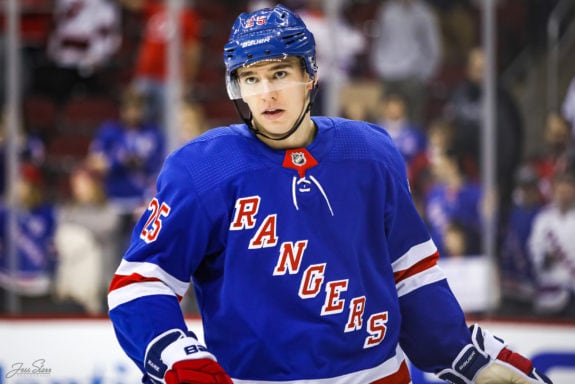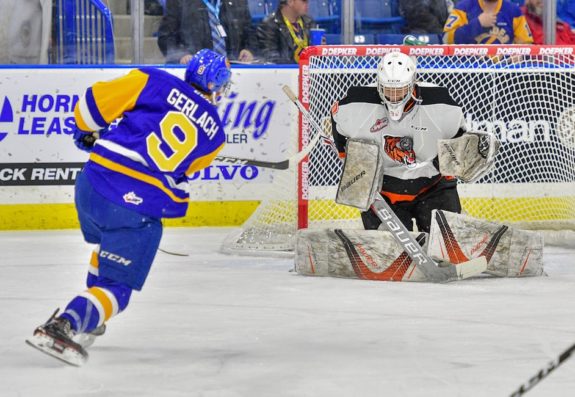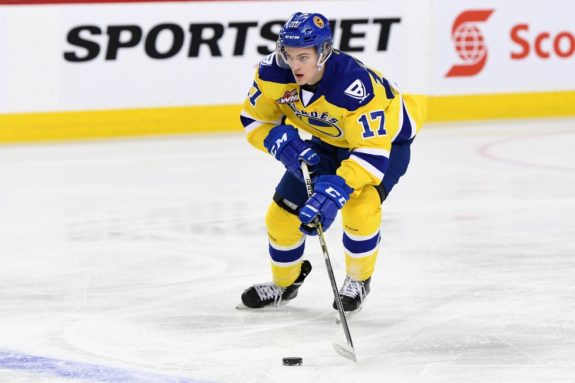Saskatoon Blades general manager Colin Priestner was moving and shaking at the 2018 Western Hockey League trade deadline.
With the Blades in the midst of a mediocre 2017-18 season and likely to miss the playoffs for a fifth straight season, Priestner executed a series of bold moves that would set Saskatoon up for success, both in the near future and for the long term.
Having not qualified for the WHL postseason since 2012-13, Saskatoon was in tough again in 2017-18. Despite a better-than-.500 record, the Blades were on their way to a last-place finish in an East Division that featured six teams with winning records including the league’s top two teams, the Moose Jaw Warriors and Swift Current Broncos.

Knowing their chances of doing damage was low even if they were to climb up the standings, Priestner made the difficult determination that major changes were needed, and proceeded to orchestrate one of the busiest and most impactful deadlines in club history.
Star Out, Stars In
To Regina: D Libor Hajek
To Saskatoon: D Dawson Davidson, C Tristen Robins, First-Round Pick
The first transaction took place two days prior to the deadline, and was perhaps the biggest of the bunch, seeing Tampa Bay Lightning drafted defenseman Libor Hajek go to rival Regina Pats in exchange for 19-year old blueliner Dawson Davidson, 16-year old center Tristen Robins and a first-round draft pick.
The return brought the Blades something to help now in Davidson and something for the future in the budding Robins.
The Price
The cost was Hajek, who played two-and-a-half seasons in Saskatoon scoring 15 goals and 77 points in 167 games, bolstered the Pats’ defense core in preparation for hosting the 2018 Memorial Cup. He contributed four goals and 14 points in 25 regular-season games for Regina. He added a goal in four playoff games as the Pats were eliminated in the first round of the WHL postseason at the hands of eventual Ed Chynoweth Cup champion Swift Current.

The Czech native had his NHL rights traded to the New York Rangers during his stint in Regina and would turn professional during his 20-year old season and make his NHL debut in 2018-19.
Dawson Davidson
Davidson brought back an immediate quality replacement for Hajek on the blue line for the Blades, who wanted to continue to compete while trying to improve for the future.
“We really felt the return (for Libor) was too substantial to turn down,” Priestner explained after the trade. “We wanted to make it clear to our team and our fans that we aren’t giving up on this season by acquiring a player of Dawson Davidson’s status as a guy who can play two years for us and has potential to be a 50-60 point guy from the back end.”
The native of Moosomin, SK broke into the WHL with the Kamloops Blazers and played parts of two seasons in Regina (2016-2018) before the move to the Blades. He registered three goals and 16 points in 26 games down the stretch for Saskatoon after the trade, but his real impact came the following season.
In his overage season in 2018-19, Davidson was the top-scoring defenseman in the WHL and led the Blades with his 75 points, which included 13 goals. He helped move the puck up to the team’s deep forward group that included centreman Kirby Dach who scored 25 goals in his draft season.
After graduating from the WHL, Davidson went to the University of Saskatchewan where he had four goals and 26 points in 29 games in 2019-20.
Tristen Robins
Robins skated in three games for the Blades in 2017-18 after the trade, and became a regular in his 17-year old rookie campaign the following season, contributing nine goals and 25 points. He then gave fans a glimpse of things to come, lighting the lamp three times in 10 playoff games.

The Blades’ top five point-scorers from that season all moved on, allowing the speedy Robins a chance to claim a top-line leadership role alongside fellow second-year forward Kyle Crnkovic in 2019-20. After a lukewarm first half, Robins found his stride in a big way in the second half of his draft season, finishing with 33 goals and 73 points in 62 games.
The San Jose Sharks took notice, selecting him in the second round of the 2020 NHL Draft.
Three-Team Blockbuster
To Saskatoon: RW Max Gerlach, G Tyler Brown, 4 Draft Picks (from Regina)
To Regina: C Cameron Hebig, G Ryan Kubic
To Medicine Hat: RW Bryan Lockner, 2 Draft Picks (from Saskatoon)
The Blades’ and Pats invited the Medicine Hat Tigers to the party on deadline day, swinging a massive three-team deal that sent star forward Cameron Hebig and goaltender Ryan Kubic to Regina from the Blades. Saskatoon received netminder Tyler Brown and a selection of draft picks from the Pats, as well as sniper Max Gerlach from the Tigers. Finally, Medicine Hat came away with winger Bryan Lockner from the Pats as well as a pair of picks from Saskatoon.
Max Gerlach
The winger from Flower Mound, TX was an offensive threat as soon as he arrived in the WHL in 2015-16, scoring 30-plus goals twice for the Tigers (2015-17) and had 16 in the first half of 2017-18 before the trade to Saskatoon.
“Max is a pure sniper who sees the game at a high level and is one of the top goal-scoring wingers in the WHL over the last three years,” Priestner said after acquiring Gerlach. “He will be a major two-year player for us and gives us the scoring threat we were looking for for our young franchise centremen. Players like [Gerlach] do not come available very often and the fact he can play for this year and next year as an overage made this decision easy for us.”
He made good on those expectations as a member of the Blades, netting 19 goals in the second half of 2017-18, and then led the team with 42 goals in 2018-19 as an overage player.

After the WHL, Gerlach took his career to Europe, playing professionally in Switzerland and most recently in Austria to begin the 2020-21 season.
Tyler Brown
The Blades’ short-term replacement for Kubic in net, Brown had spent his entire career with Regina prior to the trade. He played out his overage season, winning four of his nine appearances for Saskatoon.
After recording 80 wins in 161 WHL games, the Winnipeg, MB native enrolled at the University of Manitoba in 2019-20, appearing in 12 games and winning three.
Draft Picks to the Blades
The four draft picks transferred to the Blades from Regina included 2020 first and second-rounders, and third-rounders in 2019 and 2021. These added picks gave Saskatoon the flexibility to pull the trigger on their final deal of the 2018 deadline.
The Price
Hebig was a fixture with the Blades for four seasons (2013-18), scoring 87 goals and 193 points in 238 games. Late in 2017, the skilled centerman signed with the Edmonton Oilers as an undrafted free agent.
He played out his overage season with the Pats, notching 11 goals and 32 points in 26 games. The Saskatoon native then followed with a torrid postseason, scoring six times with eight points in seven games against Swift Current and then finished second in Memorial Cup goal scoring with four markers in five games. He has played his last two seasons in the Oilers system, primarily in the AHL.
Kubic, also an overage player, had played 20 games with Saskatoon after playing the bulk of his career with the Vancouver Giants. He won five of his 12 games down the stretch for the Pats, and started all seven of the team’s playoff games.
Despite the early exit from the WHL postseason, Regina was able to put together a strong showing as the host team of the 2018 Memorial Cup, reaching the final before falling to the QMJHL’s Acadie Bathurst Titan.
Florchuk From Victoria
To Victoria: 3 Draft Picks
To Blades: C Eric Florchuk
Priestner’s final transaction before the 2018 deadline passed was the acquisition of playmaking centerman Eric Florchuk from the Victoria Royals. The Blades sent a haul of draft picks back including two 1st round picks and a fourth-rounder. Those assets helped Victoria swing a blockbuster deal with the Brandon Wheat Kings to acquire a package headlined by Wheat Kings’ captain and St. Louis Blues prospect Tanner Kaspick.
Florchuk looked to be growing into a difference maker in his second season with the Royals, counting seven goals and 28 points in 43 games before the trade to Saskatoon. His goal-scoring pace increased after the trade, potting nine with 21 points in 28 games for the Blades to finish his draft campaign with 16 goals and 49 points.

The Washington Capitals took the Fort Saskatchewan, AB product in the seventh round of the 2018 draft, and he looked like he was going to be a key piece for the Blades for the next two seasons. His production ticked slightly upwards in 2018-19, registering 21 goals and 50 points and he was on a similar pace to start the next season before he was sent to the Vancouver Giants.
The Blades received forward Evan Patrician and two draft picks in return while Florchuk looked energized by the return to the B.C. Division, scoring at a career-best clip with his 10 goals and 33 points in 25 games.
Trade Benefits
The principal additions at the 2018 trade deadline made their biggest impacts with the Blades in two waves. The first to significantly impact the Blades were Gerlach, Florchuk, and Davidson in 2018-19, followed by Robins in 2019-20.
Gerlach and Florchuk bolstered a deep forward group in 2018-19, while Davidson supplemented the team’s attack from the back end with a team-leading 75 points, which led all WHL rearguards.
Added to the likes of Dach and 30-goal man Gary Haden, the Blades enjoyed a resurgent season with 45 wins and 98 points, good enough for second place in the Eastern Conference and a first-round playoff win.
After Davidson and Gerlach graduated following 2018-19 season, Robins became the centerpiece of the Blades’ next wave of talent, which featured five players who were listed on NHL Central Scouting’s final rankings for the 2020 NHL Draft. The new core grew into their new roles during the course of the 2019-20 season, and were able to lock down their second straight playoff berth before the COVID shutdown.

If the WHL is successful in its hopes for a January 8, 2021 start to the new season, Robins again be called upon to lead the charge, supported by Crnkovic and centerman Chase Wouters, who is slated to become the first three-year captain in Blades’ franchise history.
High Risk, High Reward
When it all shook out, Priestner did an excellent job of turning current assets on a mediocre team into future key pieces on a sustainable playoff squad. Moving an NHL prospect like Hajek and a fan favorite like Hebig are not easy moves to make, but they are the bold decisions that were needed to affect a major change in the Blades’ fortunes.